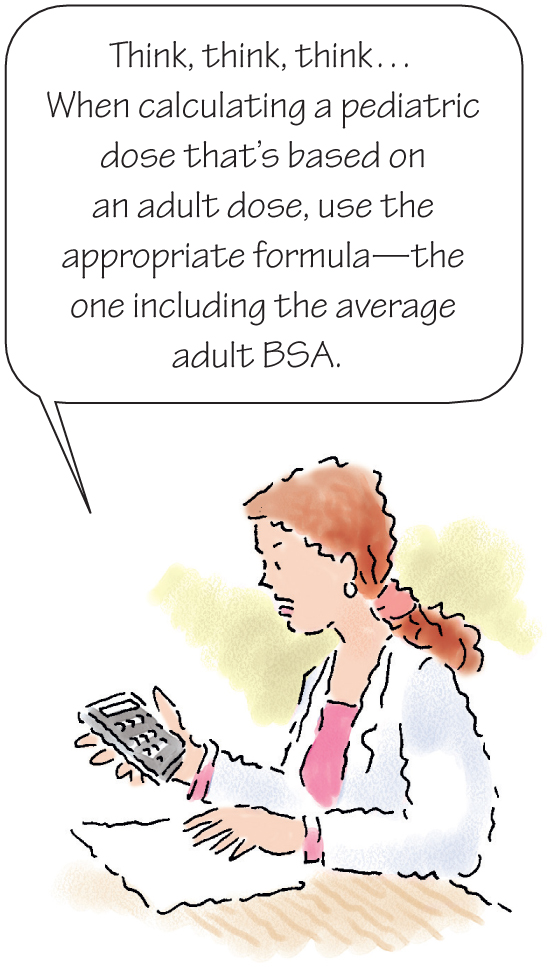To calculate and verify the safety of pediatric drug dosages, use the dosage-per-kilogram-of-body-weight method or the body surface-area (BSA) method. Other methods, such as those based on age or the stand ard dosing used for adults, are less accurate and typically aren't used.
Whichever method you use, remember that you're professionally and legally responsible for checking the safety of a prescribed dose prior to administration. Double-check your calculations with the pharmacist or another registered nurse.
Dosage per kilogram of body weight
Many pharmaceutical companies provide information about safe drug dosages for pediatric patients in milligrams per kilogram of body weight. This is the most accurate and common way to calculate pediatric dosages. Pediatric dosages are usually expressed as mg/kg/day or mg/kg/dose. Based on this information, you can determine the pediatric dose by multiplying the child's weight in kilograms by the required number of milligrams of drug per kilogram.
Shifting weight: From pounds to kilograms
Because most patients' weights are measured in pounds (lb), you must convert from pounds to kilograms before calculating the dosage per kilogram of body weight. Remember that 1 kg equals 2.2 lb.
The following examples show how to use proportions to convert pounds to kilograms, how to calculate mg/kg/dose for one-time or as-needed (p.r.n.) medications, and how to calculate mg/kg/day for doses given round-the-clock to maintain a continuous drug effect.

A weighty problem
If your 6-year-old patient weighs 41.5 lb, how much does he weigh in kilograms?
Here's how to solve this problem using ratios.
Set up the proportion, remembering that 2.2 lb equals 1 kg:

Multiply the extremes and the means:

Solve for X by dividing each side of the equation by 2.2 lb and cancelling units that appear in both the numerator and denominator:
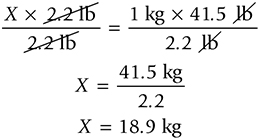
The child weighs 18.9 kg, which may be rounded off to 19 kg.
Note this: If you prefer using Dimensional Analysis to calculate dosages, feel free to do so! Refer back to Chapter 4 if you get stuck!

Milligram mystery
The doctor orders a single dose of 20 mg/kg/dose of amoxicillin oral suspension for a toddler who weighs 20 lb (9.1 kg). What's the dose in milligrams?
Here's how to solve this problem using fractions.
Set up the proportion with the ordered dosage in one fraction and the unknown dosage and the patient's weight in the other fraction:

Cross-multiply the fractions:

Solve for X by dividing each side of the equation by 1 kg/dose and cancelling units that appear in both the numerator and denominator:

The patient needs 180 mg of amoxicillin.
A perplexing penicillin problem
The doctor orders penicillin V potassium oral suspension 56 mg/ kg/day in four divided doses for a patient who weighs 55 lb. The suspension that's available is penicillin V potassium 125 mg/5 mL. What volume should you administer for each dose?
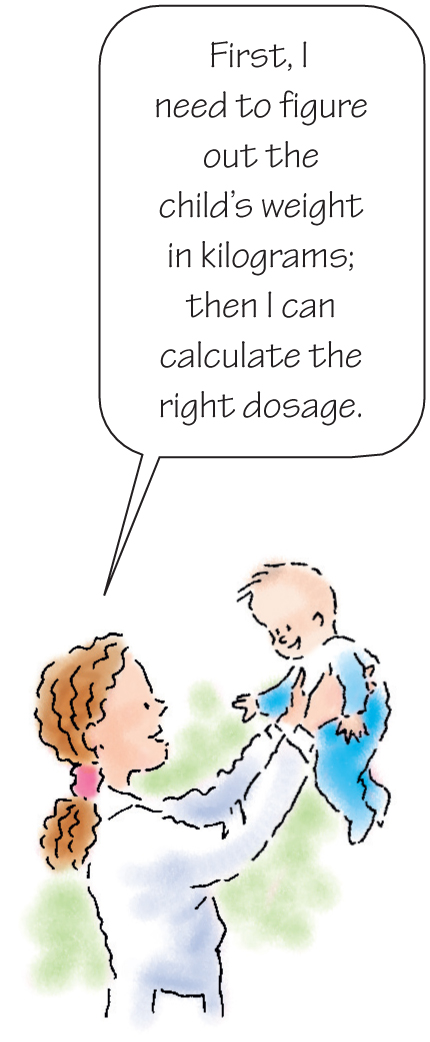
Here's how to solve this problem using ratios and fractions.
First, convert the child's weight from pounds to kilograms by setting up the following proportion:

Multiply the extremes and the means:

Solve for X by dividing each side of the equation by 2.2 lb and cancelling units that appear in both the numerator and denominator:
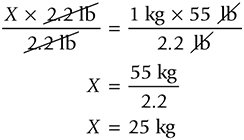
The child weighs 25 kg. Next, determine the total daily dosage by setting up a proportion with the patient's weight and the unknown dosage on one side and the ordered dosage on the other side:

Cross-multiply the fractions:

Solve for X by dividing each side of the equation by 1 kg and cancelling units that appear in both the numerator and denominator:
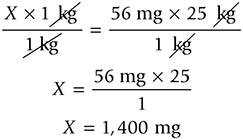
The child's daily dosage is 1,400 mg. Now, divide the daily dosage by 4 doses to determine the dose to administer every 6 hours:

Test your math skills with this drill

How many milligrams of a medication will a nurse give to a 32-lb child if the order calls for 25 mg/kg?
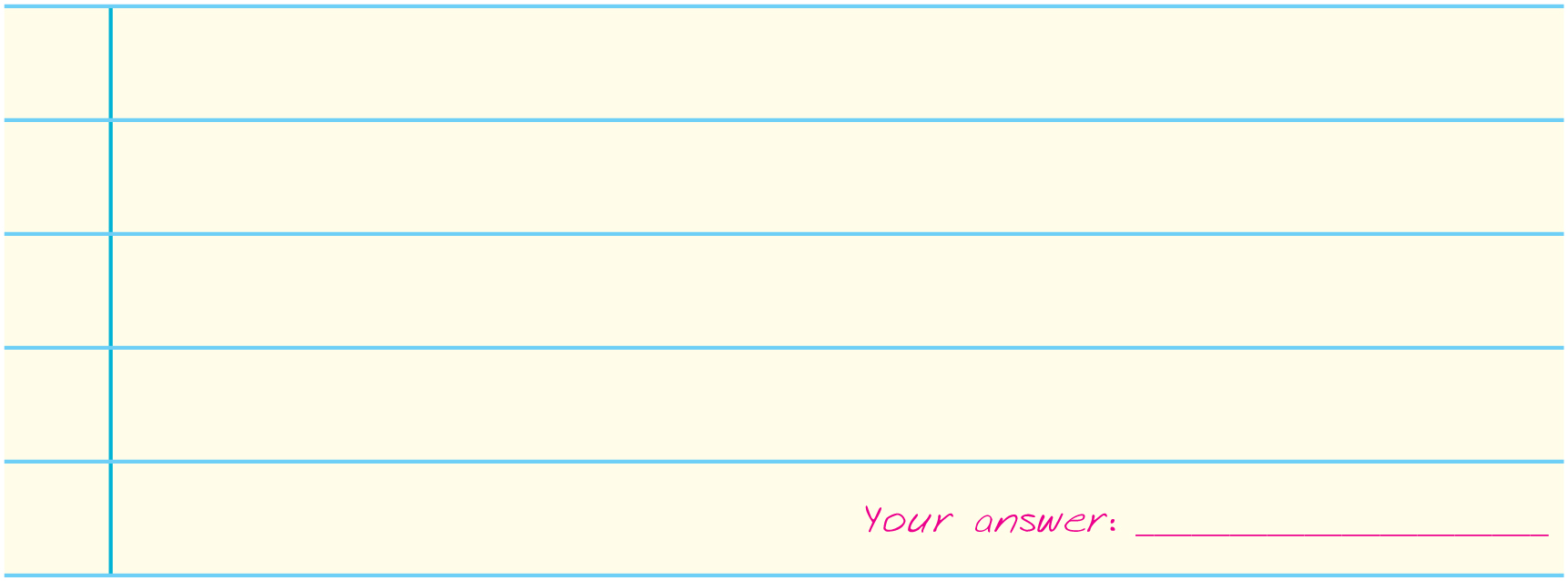
First find the child's weight in kilograms by setting up ratios and a proportion and solving for X.
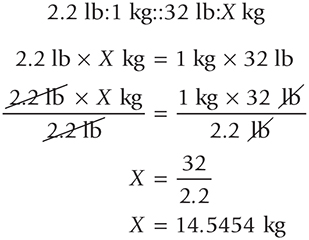
Now, find the total number of milligrams to give based on the child's weight.

The nurse would give 363.6 mg of medication.

The child should receive 350 mg every 6 hours.
Lastly, calculate the volume to give for each dose by setting up a proportion with the unknown volume and the amount in one dose on one side and the available dose on the other side:

Cross-multiply the fractions:

Solve for X by dividing each side of the equation by 125 mg and cancelling units that appear in both the numerator and denominator:

You should administer 14 mL of the drug at each dose.

Test your math skills with this drill

A 52-lb (23.6-kg) child receives 5 mg/kg of phenytoin (Dilantin) for seizure control in two divided doses. The bottle contains a concentration of 125 mg/5 mL. How many milliliters per dose should the nurse instruct the parents to administer?

First calculate the required milligrams.

Then calculate the required milliliters.

Finally, determine the amount per dose.

The parents should give 2.35 mL with each dose.
The BSA method is used to calculate safe pediatric dosages for a limited number of drugs, such as antineoplastic or chemotherapeutic agents. (It's also used to calculate safe dosages for adult patients receiving these extremely potent drugs or drugs requiring great precision.)
BSA plot thickens
Calculating dosages by BSA involves two steps:
Plot the patient's height and weight on a chart called a nomogram to determine the BSA in square meters (m2). (See What's in a nomogram?.)
Multiply the BSA by the prescribed pediatric dose in mg/m2/day.
Here's the formula:

The BSA method can also be used to calculate a child's dose based on the average adult BSA—1.73 m2—and an average adult dose.
The formula looks like this:

The following problems show how these two formulas are used in the BSA method of dosage calculation.

An engrossing ephedrine equation
The doctor orders ephedrine 100 mg/m2/day for a child who's 40" tall and weighs 64 lb. How much ephedrine should the child receive daily?
Use the nomogram to determine that the child's BSA is 0.96 m2.
Using the appropriate formula, determine the daily dosage:

Solve for X:

The child needs 96 mg of ephedrine per day.
A captivating chemotherapy question
A child who needs chemotherapy is 36" tall and weighs 40 lb. What's the safe drug dose if the average adult dose is 1,000 mg?
Use the nomogram to determine that the child's BSA is 0.72 m2.
Then set up an equation using the appropriate formula. Divide the child's BSA by 1.73 m2 (the average adult BSA), and multiply by the average adult dose, 1,000 mg:

Solve for X by cancelling units that appear in both the numerator and denominator, multiplying the child's BSA by the average adult dose, and dividing the result by the average adult BSA:

The safe dose for this child is 416 mg.
